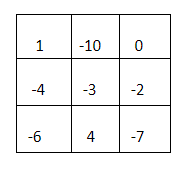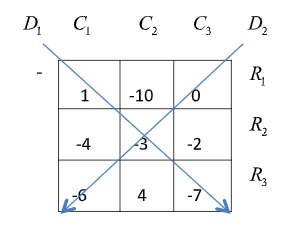
In a magic square, each row, each column, each diagonal have the same sum. Check if this is a magic square.


Answer
509.1k+ views
3 likes
Hint: Here we have a grid filled with integers. We check if the sum of elements of every row is equal to sum of elements of every column and equal to sum of elements of every diagonal. If all the sums are equal to the same constant, we say it is a magic square.
* A magic square of order
Complete step by step solution:
To solve the magic square we allot names to all rows, all columns and both diagonals to make calculations easier.
Say, the first row is denoted by
Similarly, first column is denoted by
Diagonal from top left to bottom right be denoted by

Elements of
Therefore, sum of elements of
Elements of
Therefore, sum of elements of
Elements of
Therefore, sum of elements of
Elements of
Therefore, sum of elements of
Elements of
Therefore, sum of elements of
Elements of
Therefore, sum of elements of
Elements of
Therefore, sum of elements of
Elements of
Therefore, sum of elements of
Clearly sum or elements of each row is
Sum of elements of each column is
And the sum of elements of each diagonal is
Since, numbers in each row, numbers in each column and numbers in each diagonal sum up to the same constant i.e.
Therefore this arrangement of numbers in the form of a grid is a magic square.
Note:
Students should be aware of the meaning of terms ‘Rows’ and ‘Columns’ as it can create confusion sometimes. A Row is the horizontal data arrangement and a column is the vertical data arrangement.
* Generally, a magic square has all elements as positive distinct numbers, then constant sum is called ‘Magic constant’ or ‘Magic sum’ and is denoted by
* A magic square of order
Complete step by step solution:
To solve the magic square we allot names to all rows, all columns and both diagonals to make calculations easier.
Say, the first row is denoted by
Similarly, first column is denoted by
Diagonal from top left to bottom right be denoted by

Elements of
Therefore, sum of elements of
Elements of
Therefore, sum of elements of
Elements of
Therefore, sum of elements of
Elements of
Therefore, sum of elements of
Elements of
Therefore, sum of elements of
Elements of
Therefore, sum of elements of
Elements of
Therefore, sum of elements of
Elements of
Therefore, sum of elements of
Clearly sum or elements of each row is
Sum of elements of each column is
And the sum of elements of each diagonal is
Since, numbers in each row, numbers in each column and numbers in each diagonal sum up to the same constant i.e.
Therefore this arrangement of numbers in the form of a grid is a magic square.
Note:
Students should be aware of the meaning of terms ‘Rows’ and ‘Columns’ as it can create confusion sometimes. A Row is the horizontal data arrangement and a column is the vertical data arrangement.
* Generally, a magic square has all elements as positive distinct numbers, then constant sum is called ‘Magic constant’ or ‘Magic sum’ and is denoted by
Recently Updated Pages
Master Class 11 Economics: Engaging Questions & Answers for Success

Master Class 11 Business Studies: Engaging Questions & Answers for Success

Master Class 11 Accountancy: Engaging Questions & Answers for Success

Questions & Answers - Ask your doubts

Master Class 11 Accountancy: Engaging Questions & Answers for Success

Master Class 11 Science: Engaging Questions & Answers for Success

Trending doubts
Full Form of IASDMIPSIFSIRSPOLICE class 7 social science CBSE

Whom did king Ashoka send to Sri Lanka to spread Buddhism class 7 social science CBSE

The southernmost point of the Indian mainland is known class 7 social studies CBSE

How many crores make 10 million class 7 maths CBSE

AIM To prepare stained temporary mount of onion peel class 7 biology CBSE

Find HCF and LCM of 120 and 144 by using Fundamental class 7 maths CBSE





